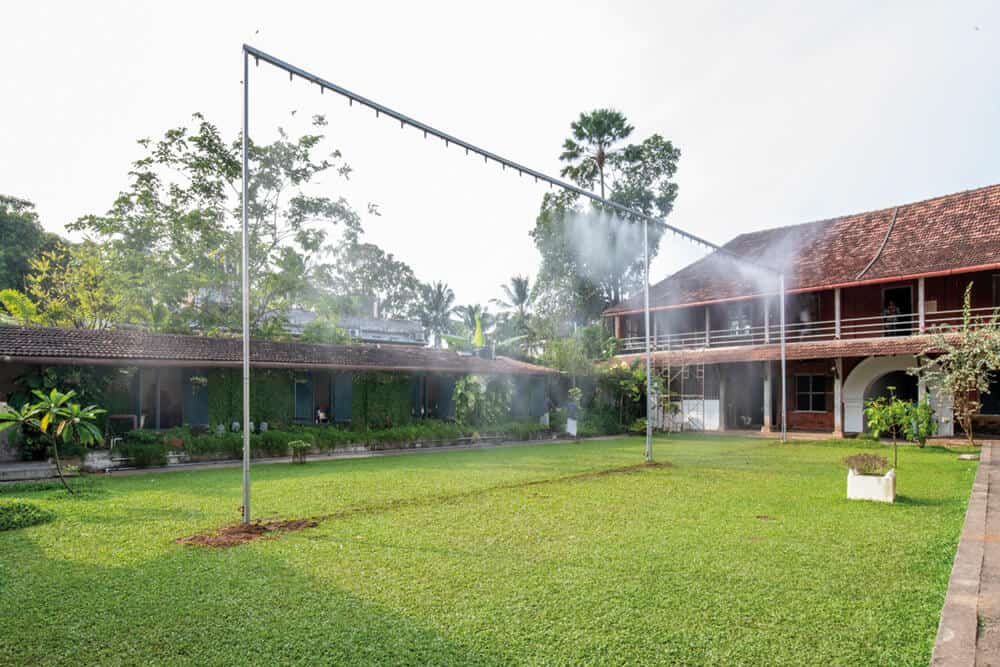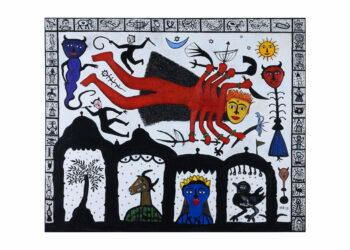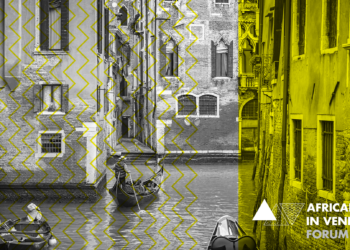Fourth edition: Kochi-Muziris Biennale
The fourth edition of the Kochi-Muziris Biennale marks a significant shift in the curatorial model and process adopted by Anita Dube. Dube, the first woman to curate the Biennale, was a member of the Indian Radical Painters and Sculptors Association in the 1980s, and this year’s curatorial theme, “Possibilities For a Non-Alienated Life”, reflects her political energy.
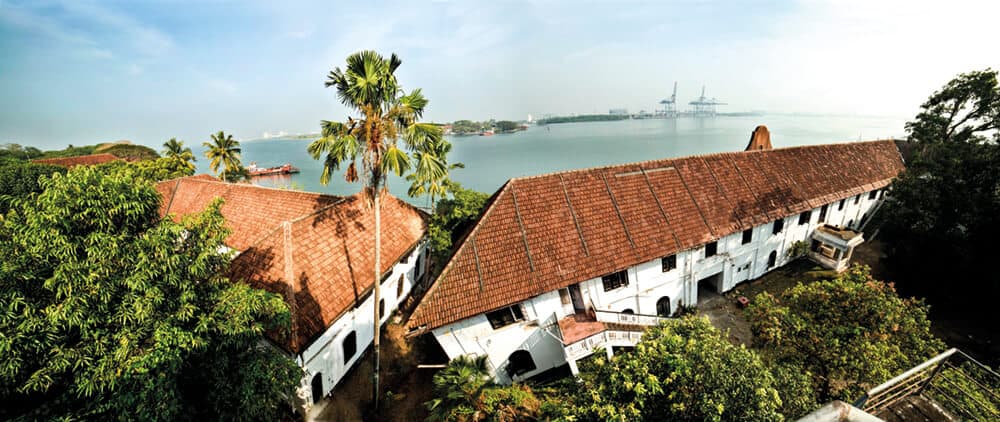 Aspinwall House is a large sea-facing heritage property in Fort Kochi. The property was originally the business premises of Aspinwall & Company Ltd. established in 1867 by English trader John H Aspinwall. Under the guidance of Aspinwall the Company traded in coconut oil, pepper, timber, lemongrass oil, ginger, turmeric, spices, hides and later in coir, coffee, tea and rubber. The large compound contains office buildings, a residential bungalow and a number of warehouses and smaller outer-lying structures. Aspinwall House is the primary venue of the Biennale, hosting numerous artist-led projects and events spaces.
Aspinwall House is a large sea-facing heritage property in Fort Kochi. The property was originally the business premises of Aspinwall & Company Ltd. established in 1867 by English trader John H Aspinwall. Under the guidance of Aspinwall the Company traded in coconut oil, pepper, timber, lemongrass oil, ginger, turmeric, spices, hides and later in coir, coffee, tea and rubber. The large compound contains office buildings, a residential bungalow and a number of warehouses and smaller outer-lying structures. Aspinwall House is the primary venue of the Biennale, hosting numerous artist-led projects and events spaces.
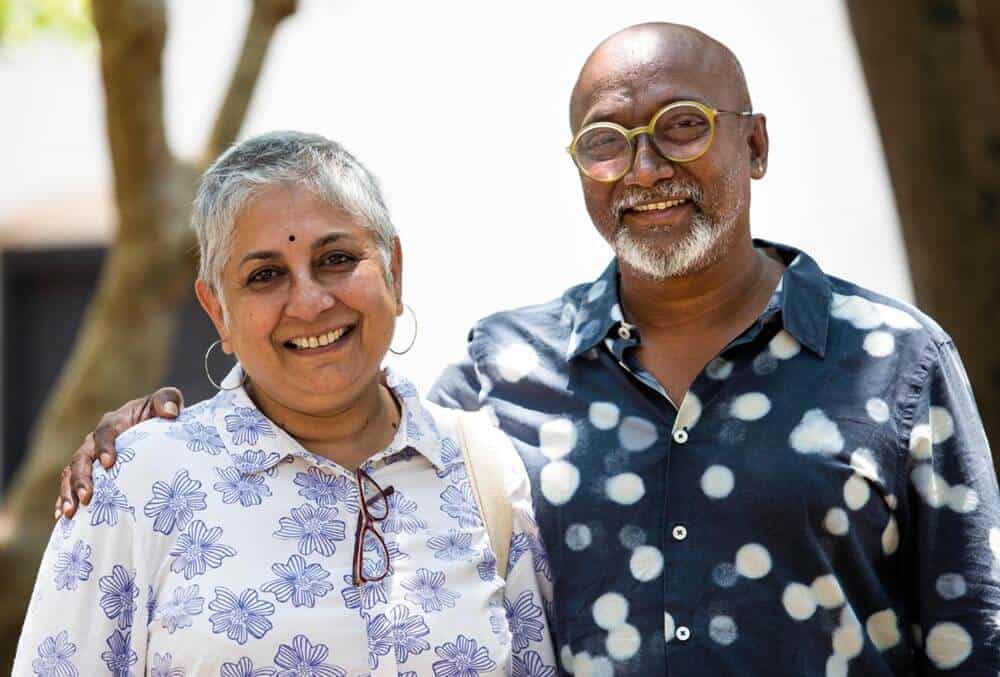 Anita Dube, and Kochi Biennale Foundation president Bose Krishnamachari. Courtesy of Kochi Biennale Foundation.
Anita Dube, and Kochi Biennale Foundation president Bose Krishnamachari. Courtesy of Kochi Biennale Foundation.
The 4th edition of the Kochi-Muziris Biennale opened in December 2018. Curated by artist Anita Dube, this edition sees a marked shift in the curatorial process and model. Dube’s vision is to bring freedom and greater community engagement to Kochi and this extends to her selection of and the diversity reflected among international artists invited to participate
The first woman to curate the Kochi-Muziris Biennale, Dube has included over 90 artists from 30 countries. More than 100 projects are displayed in heritage properties, public spaces, and galleries across the Fort Kochi, Mattancherry and Ernakulam neighbourhoods of Kochi City. Along with the carefully designed exhibition spaces, the Biennale Pavilion at Cabral Yard is a central space of dialogue that continuously shapes the Biennale both in the thematic frame and experientially. Several other projects are shown outside the exhibition space and throughout the city, enlivening the urban fabric of Kochi, and creating a new type of public engagement. In addition, there are a number independently curated programmes known as “infra-projects”, all responding to the wider curatorial theme.
‘Possibilities For a Non-Alienated Life’, refers to Guy Debord’s warnings of a world mediated primarily through images, a society of the spectacle. Dube explains that “from the conceptual level to the embodied experience of the Biennale visitor, ‘Possibilities for a Non-Alienated Life’ attempts to offer a platform that operates through radical openness. The exhibition – whose didactic model is complicated and liberated by a collaborative space called the Pavilion – is energised by the interactions between works, the dialogue sparked between artistic voices and practices. The audience is invited to share, to listen, and even to challenge the space”
The central collaborative space, dubbed The Knowledge Laboratory, is an open platform for sharing and learning across media and languages. Anita Dube comments: “There will be no hierarchies of knowledge or stratifications of content. It is a space for safe disagreement, uncomfortableness, and unease, as much as it is one of pleasure, celebration, and exchange. At its core, The Knowledge Laboratory is an ever-developing learning experiment that cannot be realised without public participation.”
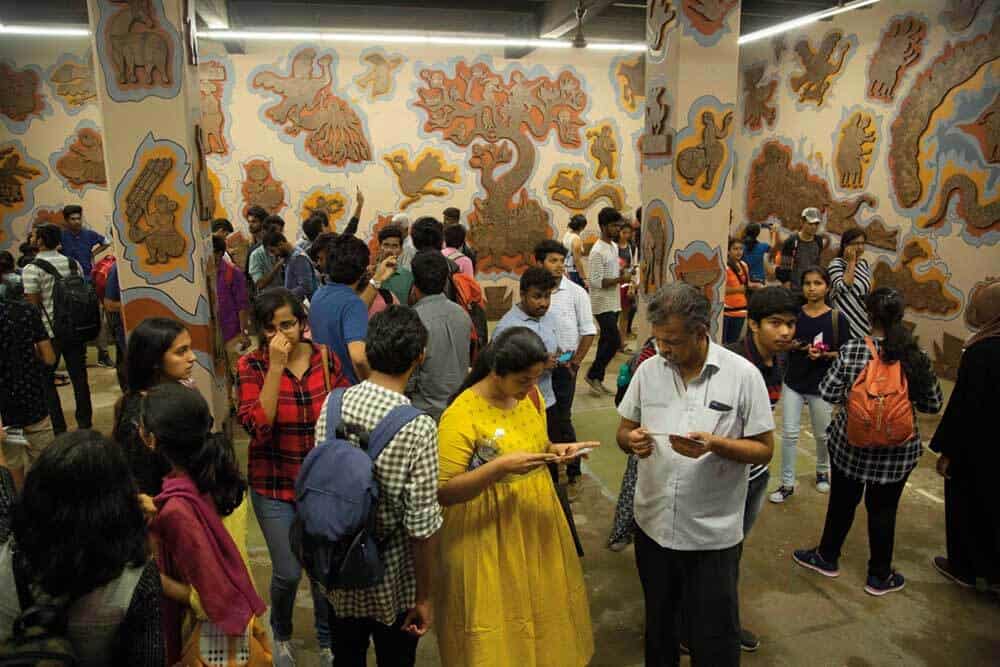 Durgabai and Subhash Vyam, installation view with crowds at Kochi-Muziris Biennale 2018. Courtesy of Kochi Biennale Foundation.
Durgabai and Subhash Vyam, installation view with crowds at Kochi-Muziris Biennale 2018. Courtesy of Kochi Biennale Foundation.
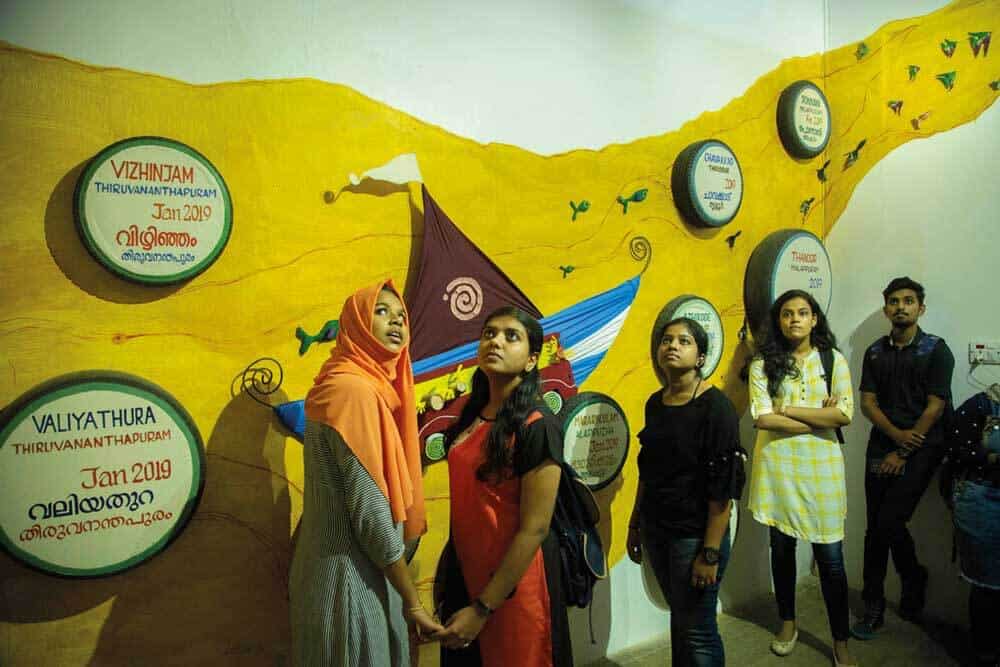 The success of the biennale’s extensive outreach and youth programmes was made quite evident by the number of young visitors to the event.
The success of the biennale’s extensive outreach and youth programmes was made quite evident by the number of young visitors to the event.
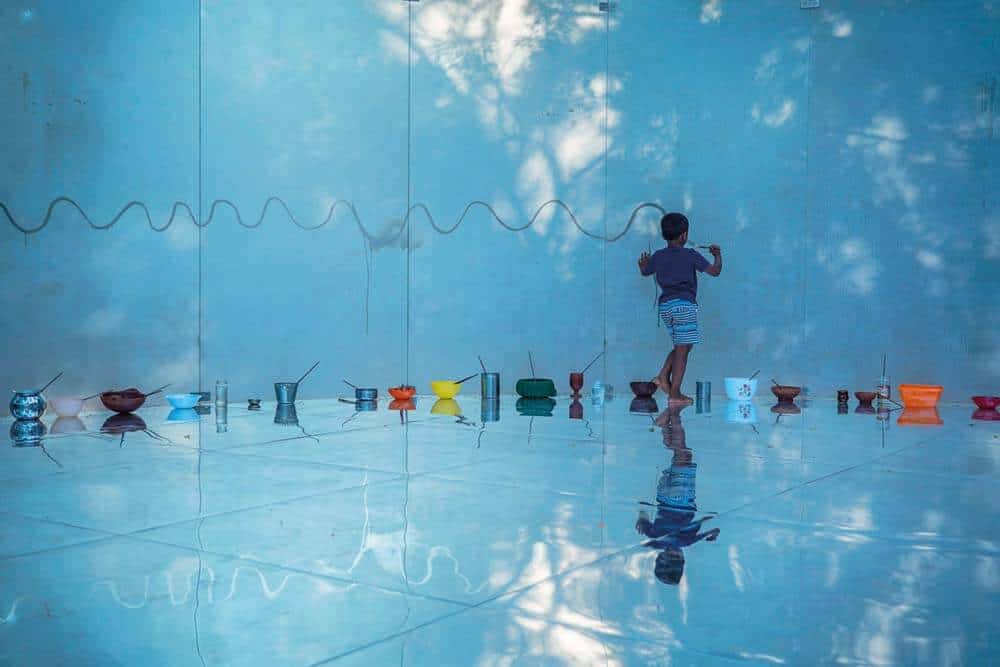 Song Dong, Water Temple Installation view at Kochi-Muziris Biennale 2018, Courtesy of Kochi Biennale Foundation. This work by the Chinese artist was a highlight at the Kochi-Muziris Biennale 2018.
Song Dong, Water Temple Installation view at Kochi-Muziris Biennale 2018, Courtesy of Kochi Biennale Foundation. This work by the Chinese artist was a highlight at the Kochi-Muziris Biennale 2018.
Besides hosting The Knowledge Laboratory, the Biennale Pavilion at Cabral Yard is a venue for programmes and conversations such as the curated Let’s Talk, Music of Muziris, and Artists’ Cinema series.
This movement towards an inclusive art environment speaks to the founding value of the Foundation itself, that art is essential to society. In providing this open platform, Dube believes that it will allow for the creation of a sort of daily archive. On the laboratory, Dube commented: ‘There will be no hierarchies of knowledge or stratifications of content. It is a space for safe disagreement, uncomfortableness, and unease, as much as it is one of pleasure, celebration, and exchange. At its core, the knowledge laboratory is an ever-developing learning experiment that cannot be realised without public participation.’
In the spirit of inclusiveness, the curatorial process includes works addressing issues of social justice, feminism and voices from the LGBTQI+ communities. Of the 94 international artists, women artists represent a little over 50 per cent. “The audience will get a sense of what women’s role has been in the production of art” Dube explains.
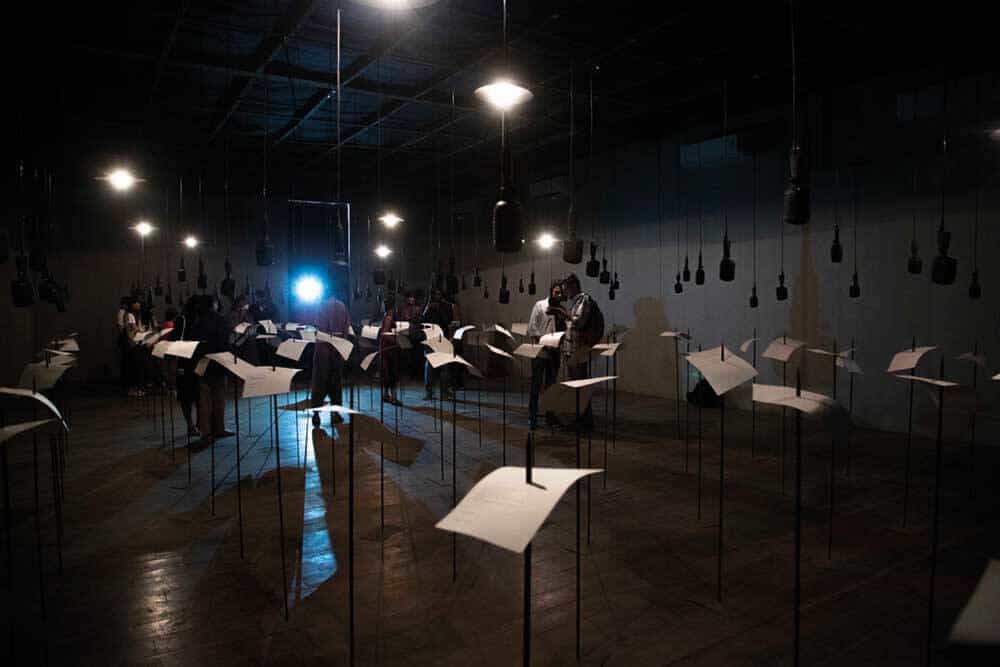 Shilpa Gupta, For, In Your Tongue, I Can Not Fit — 100 Jailed Poets, Installation view at Kochi-Muziris Biennale 2018, Courtesy of Kochi Biennale Foundation. In this work, Shilpa Gupta expands on the artist’s investigations of political borderlines, and how they exist beyond maps to the invisible mechanisms of control and surveillance. The work is an installation of one-hundred speaking microphones that sit above corresponding stakes that each hold a page of poetry. Recitals of a different poet’s work emanate from each microphone in a synchronized chorus. All of the writers who are represented, some living decades or centuries ago, were imprisoned for their poetry or politics, and the installation gives voice to their forced silence. Incarceration instigates a physical boundary between prisoners and the free world. However For, In Your Tongue, I Can Not Fit — 100 Jailed Poets, points to how orchestrated oppression is harder to detect as it renders those imprisoned voiceless and invisible.
Shilpa Gupta, For, In Your Tongue, I Can Not Fit — 100 Jailed Poets, Installation view at Kochi-Muziris Biennale 2018, Courtesy of Kochi Biennale Foundation. In this work, Shilpa Gupta expands on the artist’s investigations of political borderlines, and how they exist beyond maps to the invisible mechanisms of control and surveillance. The work is an installation of one-hundred speaking microphones that sit above corresponding stakes that each hold a page of poetry. Recitals of a different poet’s work emanate from each microphone in a synchronized chorus. All of the writers who are represented, some living decades or centuries ago, were imprisoned for their poetry or politics, and the installation gives voice to their forced silence. Incarceration instigates a physical boundary between prisoners and the free world. However For, In Your Tongue, I Can Not Fit — 100 Jailed Poets, points to how orchestrated oppression is harder to detect as it renders those imprisoned voiceless and invisible.
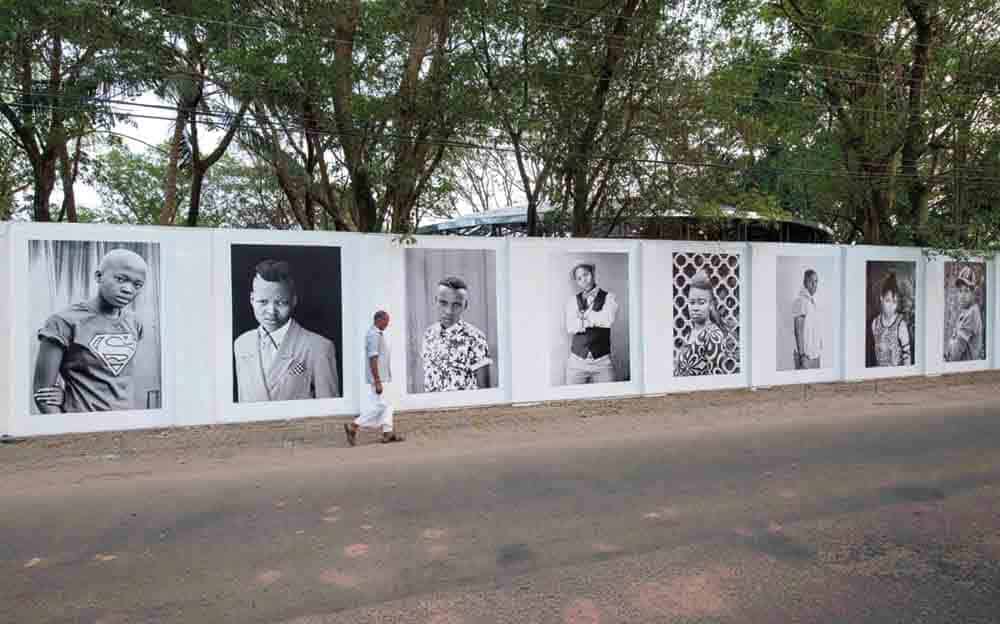 Zanele Muholi, Faces and Phases, series started in 2006, Cabral Yard, Kochi-Muziris Biennale 2018, Courtesy of Kochi Biennale Foundation.
Zanele Muholi, Faces and Phases, series started in 2006, Cabral Yard, Kochi-Muziris Biennale 2018, Courtesy of Kochi Biennale Foundation.
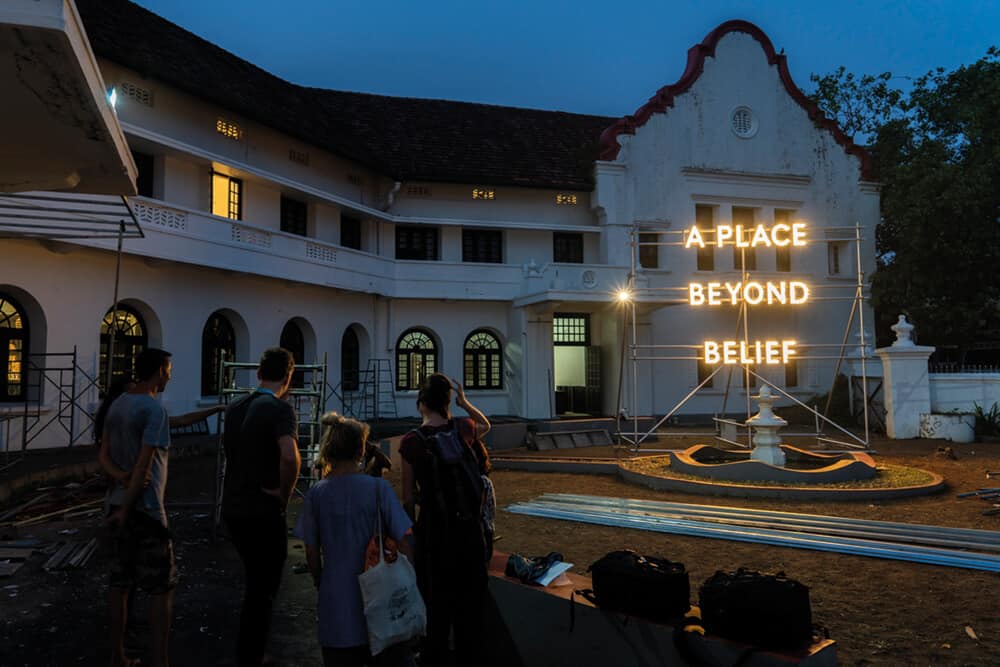 Nathan Coley, A PLACE BEYOND BELIEF, Installation view at Kochi-Muziris Biennale 2018, Courtesy of Kochi Biennale Foundation.
Nathan Coley, A PLACE BEYOND BELIEF, Installation view at Kochi-Muziris Biennale 2018, Courtesy of Kochi Biennale Foundation.
The Kochi Biennale Foundation’s commitment to promoting an artistic appreciation among the local youth in India includes the Students’ Biennale. Under the guidance of established educators and curators, the Foundation has created a mentorship programme where undergraduate and graduate students from a range of South Asian countries display their works as part of the exhibition. Many other projects have been established throughout the state to empower both art education and outreach as well as programming that has grown to include cinema, music, food, talks, conferences, performances, educational interventions, workshops, and other forms of extensive public engagement.
On 17 December 2018, the International Biennale Association and the Kochi Biennale Foundation held a public conference titled Shifting Borders: Biennales in Transforming Landscapes. The conference was opened by Hoor Al Qasimi, President of IBA, President of Sharjah Art Foundation with a keynote address from Yuko Hasegawa, Chief Curator of the Museum of Contemporary Art, Tokyo (MOT). Followed by panel discussions covering topics from biennales and community, to altered geographies, exploring the role of biennales and their ability to connect art with communities.
Following the devastating floods in the Kerala State in 2018, in which displaced so many people in the community, the Kochi Biennale Foundation arranged an art auction entitled Art Rises for Kerala (ARK). Proceeds from the sale were donated to the Government of Kerala Chief Minister’s Distress Relief Fund to help with the rebuilding efforts in the area. The auction comprised 42 lots which were generously donated by leading Indian artists – including Amrita Sher-Gil, Anish Kapoor’s, Dayanita Singh, Viswanadhan Velu, TV Santhosh, Francesco Clemente, Gulammohammed Sheikh, K M Madhusudhanan and Manu Parekh – gallerists and collectors.
No matter the collaborations and collateral events though, it is art which remains central to the Biennale and has been the reason for its astonishing success, mainly among people one wouldn’t have otherwise even thought of engaging with art.
The Biennale runs until 29th of March 2019.
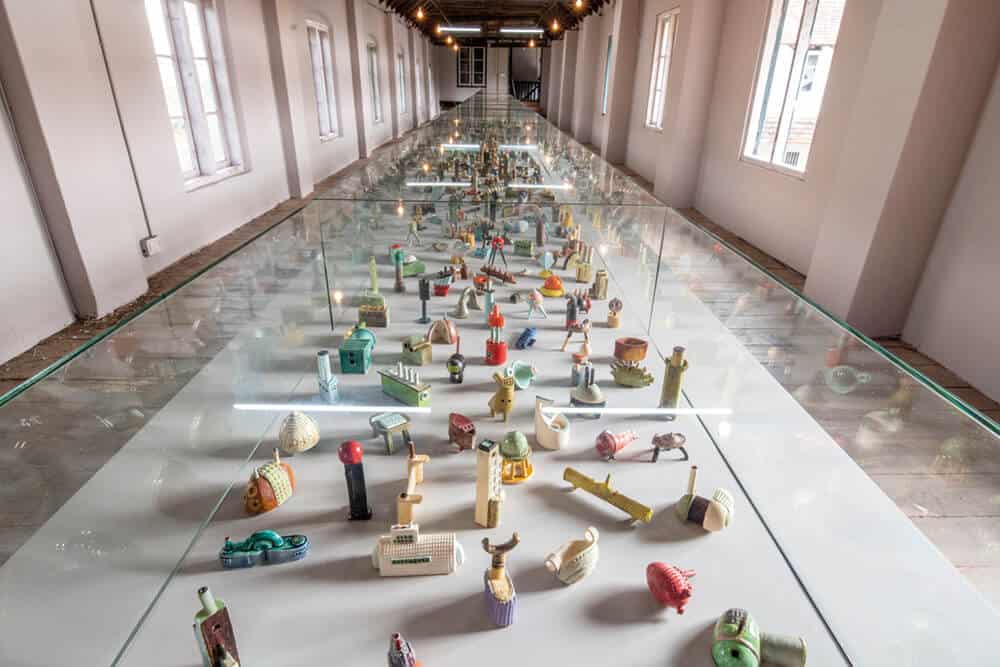 Lubna Chowdhury, Metropolis, Installation view at Kochi-Muziris Biennale 2018, Courtesy of Kochi Biennale Foundation. This multi-object work consists of over a thousand handmade clay sculptures presented in display cases. Lubna Chowdhury began Metropolis in 1991 and didn’t complete the installation of 1000 ceramic sculptures until 2017 when she first exhibited the work in its entirety at the Victoria and Albert Museum in London.
Lubna Chowdhury, Metropolis, Installation view at Kochi-Muziris Biennale 2018, Courtesy of Kochi Biennale Foundation. This multi-object work consists of over a thousand handmade clay sculptures presented in display cases. Lubna Chowdhury began Metropolis in 1991 and didn’t complete the installation of 1000 ceramic sculptures until 2017 when she first exhibited the work in its entirety at the Victoria and Albert Museum in London.
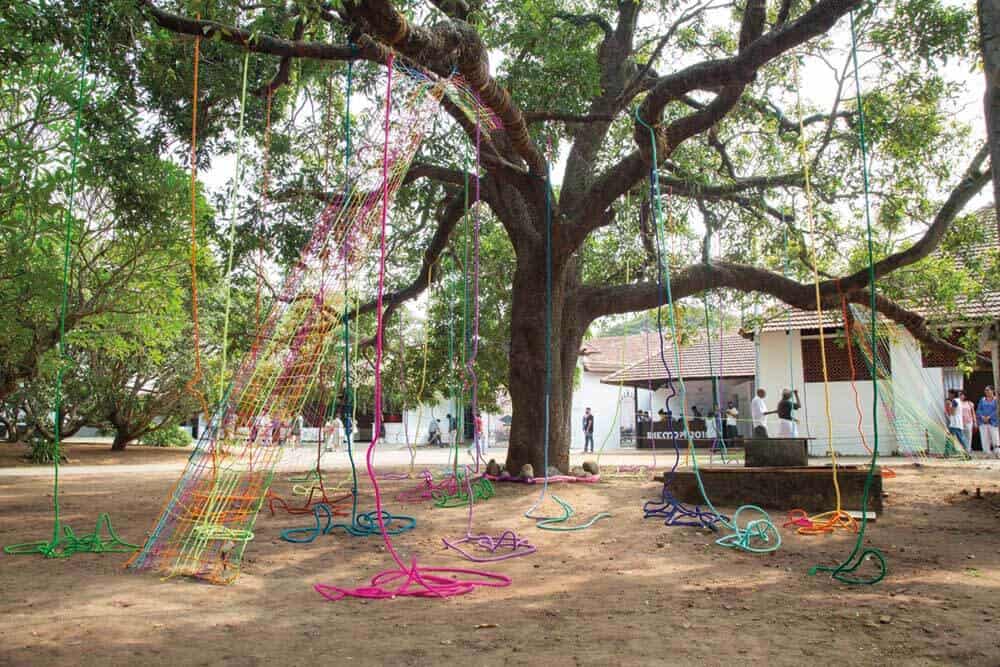 Santha K.V., Installation view at Kochi-Muziris Biennale 2018, Courtesy of Kochi Biennale Foundation. Santha K.V. is a co-founder of TASARA of upstate Malabar which is dedicated to creative weaving. The 1989-founded centre based at Beypore near Kozhikode endeavours to deliver a contemporary touch to this age-old art.
Santha K.V., Installation view at Kochi-Muziris Biennale 2018, Courtesy of Kochi Biennale Foundation. Santha K.V. is a co-founder of TASARA of upstate Malabar which is dedicated to creative weaving. The 1989-founded centre based at Beypore near Kozhikode endeavours to deliver a contemporary touch to this age-old art.
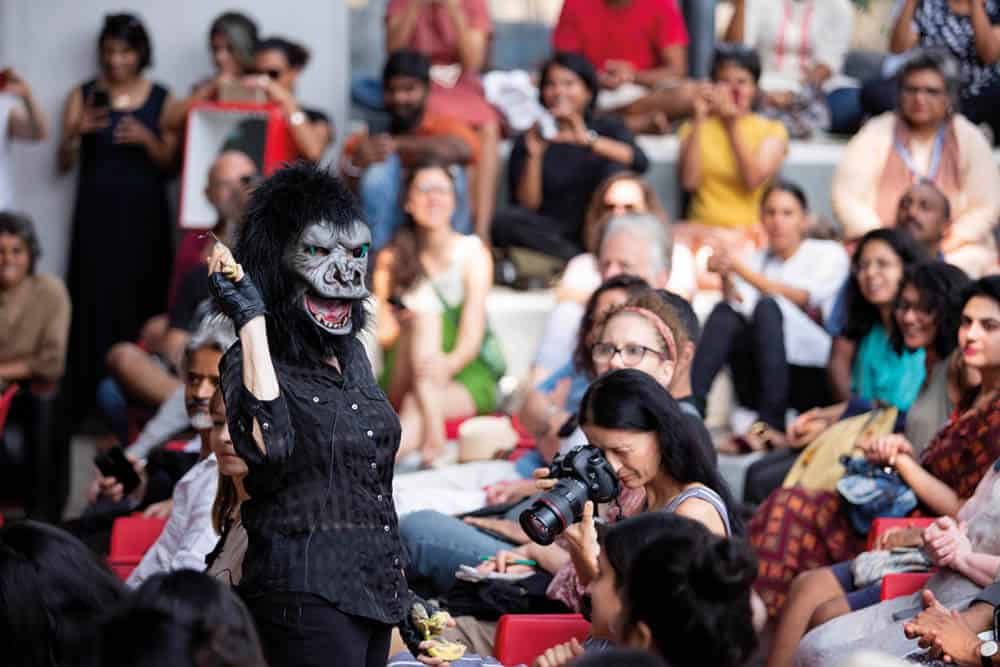 Guerrilla Girls performance, The Pavillion, Kochi-Muziris Biennale 2018. Courtesy of Kochi Biennale Foundation. The story goes that the Guerrilla Girls were originally meant to wear ski masks to hide their faces but when one of their gang accidentally spelt guerrilla wrong and wrote gorilla, they thought it would be funny to wear monkey masks instead.
Guerrilla Girls performance, The Pavillion, Kochi-Muziris Biennale 2018. Courtesy of Kochi Biennale Foundation. The story goes that the Guerrilla Girls were originally meant to wear ski masks to hide their faces but when one of their gang accidentally spelt guerrilla wrong and wrote gorilla, they thought it would be funny to wear monkey masks instead.
Participating artists include: Aernout Mik (Netherlands), Afrah Shafiq (India), Ajay Desai (India), Akram Zaatari (Lebanon), Anjali Monteiro + KP Jayasankar (India), Anju Dodiya (India), Annu Palakunnathu Matthew (India/US), Anoli Perera (Sri Lanka), Araya Rasdjarmrearnsook (Thailand), Arun Kumar HG (India), Aryakrishnan (India), Bapi Das (India), Barthélémy Toguo (Cameroon), Bracha Ettinger (Israel/France), Brook Andrew (Australia), BV Suresh (India), Celia Yunior (Cuba), Chandan Gomes (India), Chitra Ganesh (India/US), Chittaprosad (India), Cyrus Kabiru (Kenya), Dennis Muraguri(Kenya), Domenec (Spain), E.B. Itso (Denmark), Edible Archives* (India), VALIE EXPORT (Austria), Goshka Macuga (Poland/UK), Guerrilla Girls (USA), Hassan Khan + Andeel (Egypt), Heri Dono (Indonesia), Ines Doujak + John Barker (Austria + UK), Jitish Kallat (India), Julie Gough (Australia), Jun Nguyen Hatsushiba (Vietnam/Japan), Juul Kraijer (Netherlands), K.P. Krishnakumar (India), Kausik Mukhopadhyay (India), Kibuuka Mukisa Oscar (Uganda), Leandro Feal (Cuba), Lubna Chowdhary (UK), Madhvi Parekh (India), Marlene Dumas (South Africa/Netherlands), Martha Rosler (USA), Marzia Farhana (Bangladesh), Mireille Kassar (France/Lebanon), Mochu + Suvani Suri (India), Monica Mayer (Mexico), Mrinalini Mukherjee (India), Nathan Coley (UK), Nilima Sheikh (India), Oorali (India), The Otolith Group (UK), Pangrok Sulap (Malaysia), Prabhakar Pachpute (India), Priya Ravish Mehra (India), Probir Gupta (India), Radenko Milak (Bosnia and Herzegovina), Rana Hamadeh (Netherlands), Rania Stephan (Lebanon), Rehana Zaman (Pakistan/ UK), Rina Banerjee (India/USA), Rula Halawani (Palestine), Santha KV (India), Santu Mofokeng (South Africa), Satheesh PR (India), Shambhavi (India), Shilpa Gupta (India), Shirin Neshat (New York), Shubigi Rao (Singapore), Sister Library (India), Srinagar Biennale* (India), Song Dong (China), Sonia Khurana (India), Sue Williamson (South Africa), Sunil Gupta + Charan Singh (India/UK), Sunil Janah (India), Tabita Rezaire (South Africa), Tania Bruguera (Cuba), Tania Candiani (Mexico), Tejal Shah (India), Temsuyanger Longkumer (India/UK), Thomas Hirschhorn (Switzerland), Vanessa Baird (Norway), Veda Thozhur Kolleri (Kerala, India), Vicky Roy (India), Vinu VV (Kerala, India), Vipin Dhanurdharan (Kerala, India), Vivian Caccuri (Brazil), Subhash Singh Vyam + Durgabai Vyam* (India), Walid Raad / The Atlas Group (Lebanon), William Kentridge (South Africa), Young-Hae Chang Heavy Industries (South Korea), Zanele Muholi (South Africa).
